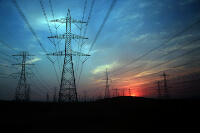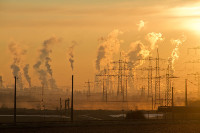
 Welcome to Episode 5 of Warming World Explained. In the past 4 episodes, I have used words like energy, heat, and power often. Even though I have been talking in everyday English, I have tried to use the terms correctly, as they are used in science and engineering. But I have never defined them or talked about how they are related to each other. But now that we have some background, and some context and examples, I think some parts of the basic science of energy will be useful to understand the issues involved in climate change.
Welcome to Episode 5 of Warming World Explained. In the past 4 episodes, I have used words like energy, heat, and power often. Even though I have been talking in everyday English, I have tried to use the terms correctly, as they are used in science and engineering. But I have never defined them or talked about how they are related to each other. But now that we have some background, and some context and examples, I think some parts of the basic science of energy will be useful to understand the issues involved in climate change.
Of course, the words are used a lot, and people use them in various ways. When politicians or economists talk about energy, they are talking about resources, the sources of energy we use to heat homes, power cars, generate electricity. That is, they are talking about coal, oil, natural gas, wind, solar, hydroelectric, nuclear, geothermal, fuel crops, and so on. When they talk about energy policy, they are referring to the political decisions about which of these resources should be taxed and which should be subsidized.
When scientists and engineers use words like energy, heat, power, and even work, they have specific technical meanings in mind. Perhaps it would be easier for students if early scientists had made up words for their technical terms. But they didn’t. They took everyday words and gave them technical meanings. Even worse, the technical meaning is usually related to the common meaning.
For instance, to a physicist, a force is a push or a pull. And a force does work when it pushes or pulls something through a distance. This means, that if you are holding a book on your outstretched palm, not moving, you are not doing work in this sense. Of course you are exerting a force to support the book’s weight. But no work is done on the book because it doesn’t move. And of course, your arm will get tired. But that is because the human body is not efficient; you have to keep expending energy from the food you eat in order to keep tensing your muscles. The human body is amazingly versatile; you can do many different things; but it is not efficient from the point of view of energy.
Now to make matters more confusing, scientists and engineers are people and they live in the world with nonscientists and nonengineers and they use words the same way other people do in their private lives. When physicists tell their spouses they are going to work, they do not mean that they are going to push crates around all day. Paperwork and staff meetings are considered work in the sense of what you do to earn a living, but not what they mean by work when doing physics. And other sciences and engineering take the use of these words from physics.
I have made a point of the technical use of the word work because energy is defined as the ability to do work. Energy comes in many forms and they can be converted from one form into another. For instance, we say that water at the top of a waterfall has potential energy, because as it falls, it will pick up speed, converting the potential energy into kinetic energy (energy of motion). That falling water can be made to turn a generator, converting the kinetic energy into electrical energy, which can power machinery to do all kinds of work. For centuries before water was used to generate electricity, waterwheels were placed in streams. The falling water turned the water wheels, and the shafts of the water wheels were connected to machines inside the factories build next to the streams.
Let’s follow the energy when you throw a ball into the air. You exert a force a ball as you extend your arm. The work you do on the ball gets converted to the kinetic energy of the ball as it leaves your hand. As the ball rises higher in the air, gravity – the force the earth exerts on the ball – slows it down. We say that kinetic energy is being converted to potential energy because after the ball reaches the highest point of its flight, gravity pulls it down and increases its speed again. That is, the potential energy was converted back into kinetic energy.
But what happens when you push a crate to get it moving across a level floor. You give it kinetic energy and then it slides to stop. What happened? The force slowing it down is friction; but friction is not like gravity. The kinetic energy of the crate has not been converted into potential energy — the only way to get it moving again is to push it again. Instead the energy has been converted into a form that we loosely call “heat”. Friction is the force one surface exerts on another to oppose sliding. To see that friction converts kinetic energy into heat, rub your together until you feel them warm up. Yes, I want you to really do it. I*’ll wait.
Ordinary, gasoline powered cars use friction bakes to stop. And when an ordinary gasoline powered car stops, its kinetic energy is converted to heat, mostly in the brakes, but also in the tires and some internal parts of the car. There is no way to make warm brakes get the car moving again. We have to burn more gasoline. The chemical potential energy of the gasoline has been (partially) converted into kinetic energy of the car, and then to heat. It has been converted from a useful form to a form we can’t use.
Heat, or thermal energy, is a peculiar form of energy. Other forms of energy: mechanical energy, both kinetic and potential, chemical energy, light, electrical energy, and many other forms can be converted completely into heat. But heat can at best be partially converted into other forms. Consider the gasoline engine in the car. The gasoline gets mixed with air and let into the cylinder and compressed. A spark from the spark plug caused the gas to explode. The hot gas pushes the piston, driving the crankshaft, which drives the car. But the point here is that the gasoline is used to generate heat, albeit at a high temperature. Some of that energy ends up as kinetic energy of the car, but far from all of it. That is why the engine needs a cooling system to circulate coolant through the engine where it gets hot and then through the radiator to cool it off again by giving the heat to the air. If you have driving any distance, the engine will stay warm for quite a while after you stop. This is why cats like to sleep on the hoods of cars.
This one-way-ness, this ability of other forms of energy to be converted completely to heat, but not the other way around, is a fundamental principal and we’ll see it in action in many examples. Not only friction, but air resistance on the outside fo the car, resistance of the water on a boat, electrical resistance in electrical circuits, all turn other forms of energy into heat.
We could make cars much more efficient if we didn’t use friction for breaking. For instance, the hybrid car has both a gasoline engine and an electric motor big enough to drive the car, and at low speeds the car usually runs entirely on electricity. When the driver applies the brake, a generator converts much of the kinetic energy back into electrical energy which is used to charge the battery. This is called regerative breaking. It is impossible to convert 100% of the kinetic energy of the car back into electrical energy, because there is always some friction in the moving parts and some electrical resistance in the circuit. But the more of the kinetic energy can be saved, the longer the car can run on electricity, and the less new gasoline is needed to get the car up to speed again. This is the main reason why hybrid cars get much better gas milage than comparable gasoline-only cars.
Throughout the discussion I have been implicitly assuming that when energy is converted from one form to another, the total quantity – including heat – is the same afterwards as before. This is actually a well-documented and studied principle called the conservation of energy. Two things need to be said about this:
First, this is a technical use of the word “conservation” In everyday English, conservation means saving something instead of using it, or using less. It means driving a Prius instead of a Hummer, not dumping industrial waste in rivers, adding land to national parks, etc.
In science: conservation means that a quantity is neither created nor destroyed.
Many people today have trouble understanding or believing in conservation of energy. Partly this is because the subject is often very badly taught in grade school or junior high. But also, unless you take science courses at a higher level, it is not treated quantitatively. And when you say that the amount of something doesn’t change, it only makes sense if you can measure the amount. But quantitative experiments and mathematical derivations by many people over the last 200 years or so bear out that energy is conserved in the technical sense.
If you are not persuaded, let me make an analogy and ask for the benefit of the doubt. Because it is the numbers that make the case compelling. So imagine you have a jigsaw puzzle, but not the box it came in. You dump the pieces out on a table and move pieces of the same color near each other. Perhaps you decide the picture is a horse pulling a cart, or a sunset at the beach, or whatever the pieces suggest. But you are guessing; you aren’t sure. But if you put the puzzle together, with every little bump fitted into the matching hollow, then you can look at the picture and know what it is without any doubt. Doing science quantitatively is like putting the puzzle together. And when everything fits, then scientists believe they understand the picture.
The important point of this for our purposes is that you can’t win; you can’t get more energy out of any process than you put in. Or, in the language of economics, there is no such thing as a free lunch.
This is one of the two major points that I would like you to take from this episode: you can’t get more energy out of any process than you put into it.
The second major point is that in all real processes, some of the energy ends up as waste heat. So useful energy is always being converted into forms that aren’t useful to us. Slowing down the rate at which this happens – as by having the hybrid car recapture some of kinetic energy as electrical energy – is one way to conserve enrgy – in the everyday sense of conserve.
Until next time, good night for Warming World Explained/



